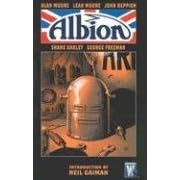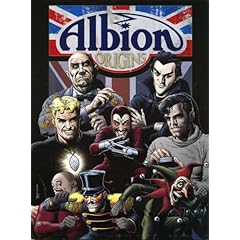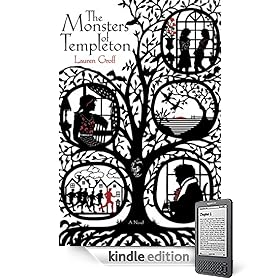Here's how this works. I read a book or two and tell you about them and try not to get too long-winded. This time, a review of
Albion (DC/Wildstorm, 2006).

In a perfect world,
Albion would have been a mammoth hit, sparking a fabulous revival of the wonderful characters of British comics' silver age and bringing all their old adventures back into print. But I suppose in that perfect world, Albion itself would have been more memorable and impressive than it actually is. It's the story of missed opportunities and a comic that reads like the rough draft of something that should have been so much better.
A quick recounting of the plot kind of goes like this: Danny, a young fellow who loves the same old British newspaper comics that I do, realizes that a newly-apprehended criminal is the villainous old Leo Baxendale character Grimly Feendish. He joins the mob outside the police station, calls out the rascal by his real name, is grabbed and spirited off by someone who turns out to be Bad Penny, the daughter of Eric Dollman, and pressganged into rebuilding Robot Archie and joining forces with Charlie Peace in order to free Grimly, Mytek the Mighty, Cursitor Doom, the Spider, the Steel Claw, Faceache, Captain Hurricane and a host of others from the remote prison where the former Eagle-Eye Junior Spy and Zip Nolan are keeping them.
This should have been the greatest comic
ever. It's nowhere close.
A really big part of its failure is down to Shane Oakley's art. He proves himself, via the flashbacks, to be a talented fellow, able to use multiple styles, but the main narrative is one of the ugliest comics I've tried to follow. There's a disorienting flatness to the characters, and distortion and curvature where we should see solid objects. It's not just that the page is two-dimensional, but rather the world the characters inhabit is equally flat. It's incredibly frustrating, especially when compared to the simiarly busy, Easter egg-filled world of, say,
Top 10, when you consider how good this book should have looked.
But Oakley could have turned out a world as rich as Ha and Cannon's and this book would still be a mess, easily one of Alan Moore's weakest stories. Alan only plotted the book, and gave it to the writing team of his daughter Leah and her husband John Reppion to script. They're said to have improved remarkably since this initial stumble, and their forthcoming
Sherlock Holmes comic is much anticipated. Somewhere between the writing and the art, so much is fumbled, and tired comic cliches are wheeled out. It even begins looking boring, with a standard early-90s Keith Giffen nine-panel page of the same repeated image of a single character, with minimal lighting changes, while two other unseen characters talk around him.
The list of apalling storytelling just goes on. Scenes abruptly end after two pages, regardless of whether they've actually reached a sensible stopping point. New characters are dumped into the narrative without explanation or introduction. This is an enormous problem throughout the prison sequences, most of which are impossible to follow without Damian Gordon's online annotations. It's simplicity itself to just have characters refer to each other by name the first time we meet them in each issue, or in the case of a dramatic buildup, tell us who we're about to meet. The cliffhanger to issue two is one of the dampest failures in the book, when a character who, after a little chin-scratching, we conclude is probably Captain Hurricane is dumped on us with no drama or sting.
Yet I think even all this could have been overcome had Bad Penny not been the most baffling, illogical character I've ever been forced to follow. Acting like she's come from evening classes at Unfair Warren Ellis Stereotype Academy, all dyed hair, chain-smoking, tough girl attitude and a refusal to explain the situation to Danny, not one word of their "relationship" is at all believable. It doesn't make sense for her to rely on and confide in Danny purely because he recognizes Grimly Feendish, and it doesn't make sense for him to stick around. If this is detailed further in the last episode, when we learn more about Danny, it sailed over my head, and I didn't follow Gordon's annotations that far.
Albion's commercial failure was unfortunate, but it did have a pair of nice legacies. DC/Wildstorm commissioned a pair of miniseries about old IPC characters in its wake. One of these,
Battler Britton by Garth Ennis and Colin Wilson, was simply wonderful and it wouldn't have existed without Albion. Additionally, Titan Books released a tie-in collection of some of these old stories,
Albion Origins, which I'll be coming back to in a few weeks. And the collected edition of this story does contain a handful of old episodes of some of these comics, even if the Zip Nolan pages are reproduced disagreeably small. It's not a complete failure, even if my personal frustrations are so high as to overwhelm any of the good that might be here, but I would nevertheless only recommend this to Alan Moore devotees who've already tackled almost everything else that's available.












